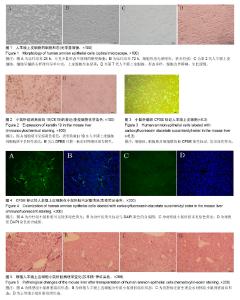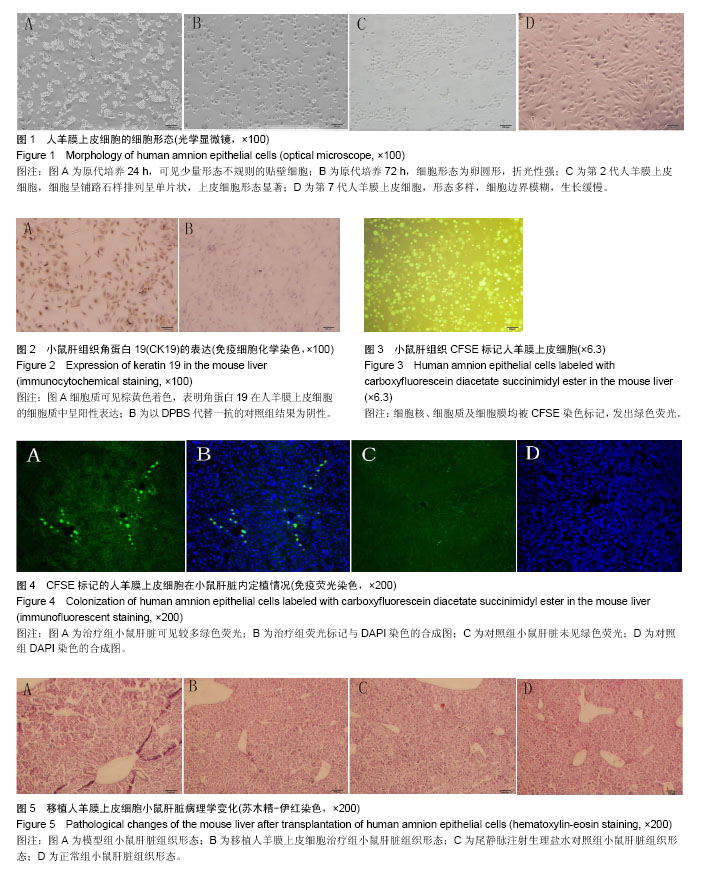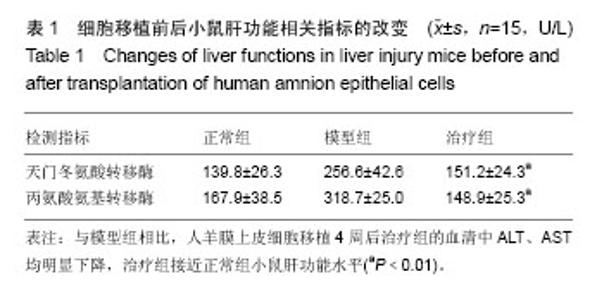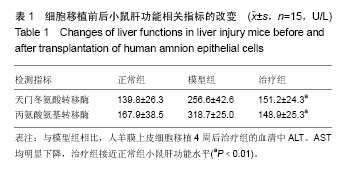| [1] 段星祥,王洋,贺菁菁,等.干细胞治疗终末期肝病的进展[J].中南大学学报(医学版),2017,42(4):457-462.[2] Meirelles LS, Fontes AM, Covas DT, et al. Mechanisms involved in the therapeutic properties of mesenchymal stem cells. Cytokine Growth Factor Rev. 2009;20(5-6):419-427.[3] Manuelpillai U, Moodley Y, Borlongan CV, et al. Amniotic membrane and amniotic cells: potential therapeutic tools to combat tissue inflammation and fibrosis. Placenta. 2011; 32: 320-325.[4] Takami T, Terai S, Sakaida I. Advanced therapies using autologous bone marrow cells for chronic liver disease. Discov Med. 2012;14(74):7-12.[5] Volarevic V, Nurkovic J, Arsenijevic N, et al. Concise review: Therapeutic potential of mesenchymal stem cells for the treatment of acute liver failure and cirrhosis. Stem Cells. 2014;32(11):2818-2823.[6] Takami T, Terai S, Sakaida I. Stem cell therapy in chronic liver disease. Curr Opin Gastroenterol. 2012;28(3): 203-208. [7] Bassiouny AR, Zaky AZ, Abdulmalek SA, et al. Modulation of AP-endonuclease1 levels associated with hepatic cirrhosis in rat model treated with human umbilical cord blood mononuclear stem cells. Int J Clin Exp Pathol. 2011;4(7): 692-707.[8] Hwang S, Hong HN, Kim HS, et al. Hepatogenic differentiation of mesenchymal stem cells in a rat model of thioacetamide-induced liver cirrhosis. Cell Biol Int. 2012;36(3):279-288.[9] 李萍,王久存,陆瑶,等.人胎盘羊膜上皮细胞的分离鉴定及多向诱导分化[J].中国组织工程研究,2017,21(9):1420-1425. [10] Kang NH, Hwang KA, Kim SU, et al. Potential antitumor therapeutic strategies of human amniotic fluid-derived stem cells. Cancer Gene Ther. 2012;19(8):517-522.[11] Zagoura DS, Roubelakis MG, Bitsika V, et al. Therapeutic potential of a distinct population of human amniotic fluid mesenchymal stem cells and their secreted molecules in mice with acute hepatic failure. Gut. 2012;61(6):894-906.[12] La Rocca G, Anzalone R, Corrao S, et al. Isolation and characterization of Oct-4+/HLA-G+ mesenchymal stem cells from human umbilical cord matrix: differentiation potential and detection of new markers. Histochem Cell Biol. 2009; 131(2):267-282.[13] Miki T, Lehmann T, Cai H, et al. Stem cell characteristics of amniotic epithelial cells. Stem Cells. 2005;23(10): 1549-1559.[14] Ilancheran S, Michalska A, Peh G, et al. Stem cells derived from human fetal membranes display multilineage differentiation potential. Biol Rep. 2007;77(3):577-588.[15] Diaz-Prado S, Muinos-Lopez E, Hermida-Gomez T, et al. Multilineage differentiation potential of cells isolated from the human amniotic membrane. J Cell Biochem. 2010; 111(4):846-857.[16] Fang CH, Jin J, Jou J H, et al. In vivo differentiation of human amniotic epithelial cells into cardiomyocyte-like cells and cell transplantation effect on myocardial infarction in rats: comparison with cord blood and adipose tissue-derived mesenchymal stem cells. Cell Transplant. 2012;21(8):1687-1696.[17] 陈少强,林建华.羧基荧光素乙酰乙酸对大鼠骨髓间充质干细胞体外染色的研究[J].福建医科大学学报,2008,42(6): 482-485.[18] Ma J Q, Ding J, Zhang L, et al. Hepatoprotective properties of sesamin against CCl4 induced oxidative stress-mediated apoptosis in mice via JNK pathway. Food Chem Toxicol. 2014;64:41-48.[19] Bhondave PD, Devarshi PP, Mahadik KR, et al. 'Ashvagandharishta' prepared using yeast consortium from Woodfordia fruticosa flowers exhibit hepatoprotective effect on CCl4 induced liver damage in Wistar rats. J Ethnopharmacol. 2014;151(1):183-190.[20] Hydes T, Wright M, Jaynes E, et al. Nitrofurantoin immune-mediated drug-induced liver injury: a serious complication of a commonly prescribed medication. BMJ Case Rep. 2014. doi: 10.1136/bcr-2013-203136.[21] Patel RP, Lang JD, Smith AB, et al. Redox therapeutics in hepatic ischemia reperfusion injury. World J Hepatol. 2014; 6(1):1-8.[22] Kanedo M, Nagamine T, Nakazato K, et al. The anti-apoptotic effect of fucoxanthin on carbon tetrachloride-induced hepatotoxicity. Toxicol Sci. 2013; 38(1):115-126.[23] 丛姗,王秀梅,李岩,等.人羊膜间充质干细胞对四氯化碳诱导小鼠肝损伤定位修复的研究[J].中国生物工程杂志,2014, 34(8): 14-23.[24] Hwang YP, Choi JH, Jeong HG. Protective effect of the Aralia continentalis root extract against carbon tetrachloride-induced hepatotoxicity in mice. Food Chem Toxicol. 2009;47(1):75-81.[25] Debnath S, Ghosh S, Hazra B. Inhibitory effect of Nymphaeapubescens Willd flower extract on Carrageenan-induced inflammation and CCl4-induced hepatotoxicity in rats. Food ChemToxicol. 2013;59:485-491.[26] Beddowes EJ, Faux SP, Chipman JK. Chloroform, Carbon tetrachloride and glutathione depletion induce secondary genotoxicity in liver cells via oxidative stress. Toxicology. 2003;187(2-3):101-115. [27] Limaye PB, Apte UM, Shankar K, et al. Calpain released from dying hepatocytes mediates progression of acute liver injury induced by model hepatotoxicant. Toxicol Appl Pharmacol. 2003;191(3):211-226.[28] Poli G, Chiarpotto E, Albano E, et al. Carbon tetrachloride-induced inhibition of hepatocyte lipoprotein secretion: functional impairment of Golgi apparatus in the early phases of such injury. Life Sci. 1985;36(6):533-539.[29] Boll M, Weber LW, Becker E, et al. Hepatocyte damage induced by carbon tetrachloride: inhibited lipoprotein sectetion and changed lipoprotein composition. Z Naturforsch C. 2001;56(3-4):283-290.[30] 吴玉婧,郭津生.肝星状细胞、Toll样受体4信号途径、炎症及纤维化微环境与原发性肝癌发生发展的关系[J].临床肝胆病杂志,2015,31(6):876-879.[31] Chung H, Hong DP, Jung JY, et al. Comprehensive analysis of differential gene expression profiles on carbon tetrachloride-induced rat liver injury and regeneration. Toxicol Appl Pharmacol. 2005;206:27-42. |



